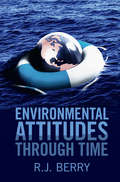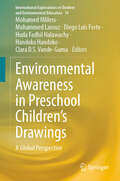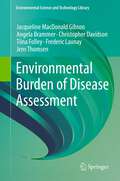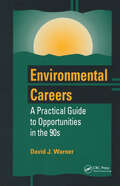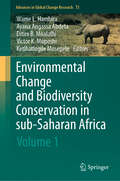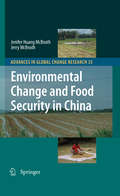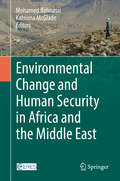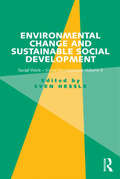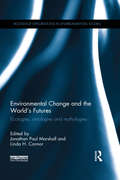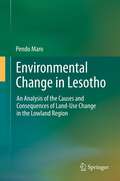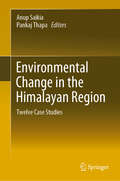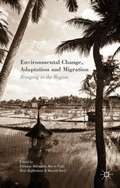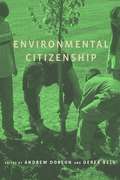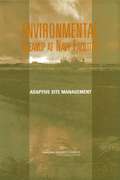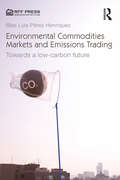- Table View
- List View
Environmental Anthropology Engaging Ecotopia
by Joshua Lockyer James R. VetetoIn order to move global society towards a sustainable "ecotopia," solutions must be engaged in specific places and communities, and the authors here argue for re-orienting environmental anthropology from a problem-oriented towards a solutions-focused endeavor. Using case studies from around the world, the contributors-scholar-activists and activist-practitioners- examine the interrelationships between three prominent environmental social movements: bioregionalism, a worldview and political ecology that grounds environmental action and experience; permaculture, a design science for putting the bioregional vision into action; and ecovillages, the ever-dynamic settings for creating sustainable local cultures.
Environmental Anthropology: A Historical Reader
by Michael R. Dove Carol CarpenterEnvironmental Anthropology: A Reader is a collection of historically significant readings, dating from early in the twentieth century up to the present, on the cross-cultural study of relations between people and their environment. Provides the historical perspective that is typically missing from recent work in environmental anthropology Includes an extensive intellectual history and commentary by the volume's editors Offers a unique perspective on current interest in cross-cultural environmental relations Divided into five thematic sections: (1) the nature/culture divide; (2) relationship between environment and social organization; (3) methodological debates and innovations; (4) politics and practice; and (5) epistemological issues of environmental anthropology Organized into a series of paired papers, which 'speak' to each other, designed to encourage readers to make connections that they might not customarily make
Environmental Attitudes Through Time
by R. J. BerryOur attitudes to our environment are widely and often acrimoniously discussed, commonly misunderstood, and will shape our future. We cannot assume that we behave as newly minted beings in a pristine garden nor as pre-programmed automata incapable of rational responsibility. <P><P>Professor Berry has studied nature-nurture interactions for many years, and also been involved with many national and international decision making bodies which have influenced our environmental attitudes. He is therefore well-placed to describe what has moulded our present attitudes towards the environment. <P>This book presents data and concepts from a range of disciplines - genetic, anthropological, social, historical and theological - to help us understand how we have responded in the past and how this influences our future. Beginning with a historical review and moving forwards to current conditions, readers will reach the end of this volume more capable and better prepared to make decisions which affect our communities and posterity.<P> Accessibly written, requiring no specific background knowledge of the reader.<P> Suggests actions the reader can take at both an individual and societal level.<P> Provides the historical context necessary to rise above the propaganda and vested interests which dominate current environmental debate.
Environmental Awareness in Preschool Children’s Drawings: A Global Perspective (International Explorations in Outdoor and Environmental Education #14)
by Mohamed Mliless Mohammed Larouz Diego Luis Forte Huda Fadhil Halawachy Handoko Handoko Clara D. S. Vande-GumaThis edited volume investigates multiple perspectives of environmental meaning-making among children by evaluating preschool children’s drawings on the environment. It critically traces the formation of early attitudes towards the environment before children’s exposure to formal environmental education. Similarities and differences are explored among preschool children's drawings across diverse cultural and geographic backgrounds. Over five sections covering Morocco, Indonesia, Nigeria, Iraq, and Argentina, each one examines the factors affecting children's environmental drawings, such as age, gender, and geography. Using different theoretical frameworks, the chapters are written by researchers of environmental discourse and ecolinguistics with a background knowledge in environmental studies from a social science perspective. This book is of interest to researchers interested in ecolinguistics and socio-semiotics fields of study. This seminal book also paves the way for further research on preschool environmental education.
Environmental Biology and Ecology Laboratory Manual
by Les M LynnIn a society concerned with climate change, overpopulation, and extinction, ecology provides a scientific link to the living world. At the individual level, ecology investigates the impact of environmental factors on organisms through their physiology and behaviour. This Sixth Edition of Environmental Biology & Ecology Laboratory Manual by Les M. Lynn contains fifteen exercises which includes Use of the Microscope and also Environmental Inventory. This will be a very useful manual and research guide for students of Environmental Biology and Ecology.
Environmental Biotechnology and Cleaner Bioprocesses
by Eugenia J. Olguín, Gloria Sánchez, Elizabeth HernándezAs we enter a new millennium, the environmental issues faced by both developing and industrialised nations are as pressing as ever. Environmental biotechnologies are increasingly being viewed as a major weapon against environmental damage. Cleaner production is part of this strategy and yet there is still widespread ignorance about this emerging technology. Environmental Biotechnology and Cleaner Bioprocesses provides this information at various levels, from introductory to advanced. The first section covers the development of cleaner bioprocesses within the framework of sustainable development. Aspects of environmental policy for small and medium businesses are then discussed using case studies to illustrate principles. The second section covers the recycling and treatment of organic waste, including the use of aquatic plants and microalgae for wastewater treatment and recovery of nutrients. Section three covers bioremediation technologies and finally, section four is dedicated to emerging cleaner bioprocesses and environmentally sound products. All chapters have been written and edited by leading authorities in the field. Students and professionals interested in environmental biotechnology and cleaner production will find the background information and detail they require in this one convenient source.
Environmental Burden of Disease Assessment
by Christopher Davidson Angela Brammer Jens Thomsen Frederic Launay Tiina Folley Jacqueline Macdonald GibsonThis publication characterizes the environmental burden of disease in the United Arab Emirates (UAE), measured by the excess number of deaths and illnesses in the population due to exposure to environmental hazards. The robust methods used in this risk analysis can be applied to any country or region. This publication documents the systematic, multi-step process used to identify environmental priorities and the detailed methods used to quantify the disease burden attributable to each risk. Based on the results of the burden of disease assessment, the publication summarizes the subsequent steps that are recommended to further reduce the burden of disease resulting from various environmental risk factors. Authors and Contributors This book represents the synthesis of research carried out by a large, interdisciplinary team from several institutions and multiple nations between June 2008 and June 2011.The lead authors are responsible for weaving together the pieces prepared by the team.Nonetheless, this book would not have been possible without major contributions from each team member.The list below shows contributors to each chapter.Following this list are biographies of all of the authors and contributors. Lead Authors Jacqueline MacDonald Gibson, Frederic J. P. Launay, Jens T. W. Thomsen, Angela Brammer, Christopher Davidson Additional Contributors (by Chapter) Chapter 2: Prioritizing Environmental Risks to Health Henry H. Willis, Aimee Curtright, Gary Cecchine, Zeinab S. Farah,Sandra A. Geschwind, Jianhui Hu, Ying Li, Melinda Moore, Sarah Olmstead, Hanine Salem, Regina A. Shih, J. Jason West Chapter 3: Assessing the Environmental Burden of Disease:Method Overview Tiina Folley, Elizabeth S. Harder, Mejs Hasan Chapter 4: Burden of Disease from Outdoor Air Pollution Ying Li, Gavino Puggioni, Prahlad Jat, Mejs Hasan, Marc Serre, Kenneth G. Sexton, J. Jason West, Saravanan Arunachalam, Uma Shankar, William Vizuete, Mohammed Zuber Farooqui Chapter 5: Burden of Disease from Indoor Air Pollution Chris B. Trent Chapter 6: Burden of Disease from Occupational Exposures Tiina Folley, Leena A. Nylander-French Chapter 7: Burden of Disease from Climate Change Richard N. L. Andrews, Leslie Chinery, Elizabeth S. Harder, J. Jason West Chapter 8: Burden of Disease from Drinking Water Contamination Gregory W. Characklis, Joseph N. LoBuglio Chapter 9: Burden of Disease from Coastal Water Pollution Gregory W. Characklis, Leigh-Anne H. Krometis, Joseph N. LoBuglio Chapter 10: Burden of Disease from Soil and Groundwater Contamination Chidsanuphong Chart-asa, Stephanie Soucheray-Grell Chapter 11: Burden of Disease from Produce and Seafood Contamination Leigh-Anne H. Krometis, Leslie Chinery
Environmental Careers: A Practical Guide to Opportunities in the 90s
by David J. WarnerEnvironmental Careers presents a broad-based, yet concise survey of employment opportunities in the environmental field. The book stresses the need for students to develop a strong technical background in the sciences to be effective in understanding and solving complex environmental problems. It also emphasizes the importance of developing relevant work experience through internships or volunteer work to help find entry-level employment in the environmental field. Environmental Careers includes opportunities in natural resources management, environmental protection, environmental health and safety, environmental education, allied environmental careers, and non-degree technical careers. Important issues for students, guidance counselors, and mid-career changers, such as salaries, characteristics of employers, and the latest trends in demands for environmental professionals, are addressed. The book also presents the 10 best career prospects for the 1990s and offers guidance on developing and implementing a personal action plan for pursuing an environmental career.
Environmental Certification for Organisations and Products: Management approaches and operational tools (Routledge Research in Sustainability and Business)
by Francesco Testa Tiberio Daddi Fabio IraldoEnvironmental certification is an effective tool for managing the environmental impact of companies, leveraging their competitive capabilities and ensuring their compliance with environmental principles. A growing number of countries across the world are adopting this practice and the growth of new environmental standards – with different scopes, aims and roles – calls for a clear and updated systematization of the issue. This book provides a comprehensive, up-to-date overview of the different environmental certification tools. As well as examining practical methods of implementing the standards for each type of certification, the book discusses their added value from a corporate management perspective. In identifying the most important requirements and standards for the issuing of environmental certification of both products and processes, the book demonstrates how companies can use operational methods to develop an environmental management system or a product certification in practice. Balancing a complete theoretical presentation of the issue with an operational perspective, the book supports the adoption and implementation of environmental certification tools. It will be a valuable resource for professionals as well as students and scholars of environmental management, sustainable business and corporate social responsibility.
Environmental Change and Biodiversity Conservation in sub-Saharan Africa: Volume 1 (Advances in Global Change Research #75)
by Wame L. Hambira Ayana Angassa Abdeta Ditiro B. Moalafhi Victor K. Muposhi Ketlhatlogile MosepeleThis volume set provides critical strategies for sustainable environmental management and biodiversity conservation in sub-Saharan Africa. They address key conservation issues in the region such as habitat loss, fragmentation, rangeland degradation, and human-wildlife conflicts. Innovative approaches in ecological modelling, climate change adaptation, and circular water systems, enhancing conservation efforts and ensuring resilience in the face of environmental changes are further examined. A comprehensive analysis of fisheries management and sustainable practices underscores their role in conserving aquatic biodiversity. Despite challenges like agricultural expansion and water scarcity, the focus on regenerative agriculture and food production systems seeks to mitigate impacts on rangelands and forests, thus supporting biodiversity conservation. Emphasizing the integration of traditional knowledge with contemporary conservation science, these volumes highlight the need for holistic, adaptive strategies and robust governance frameworks to address the complexities of biodiversity loss and environmental change. The collection is an essential resource for policymakers, researchers, and conservation practitioners dedicated to fostering sustainable livelihoods and conserving the unique ecosystems of sub-Saharan Africa. Volume 1 covers the themes of biodiversity conservation in the Anthropocene and sustainable rangeland and forest management. It provides an understanding of the dual impacts of human activities on biodiversity and underscores the necessity of sustainable forest management to enhance ecosystem services vital for rural livelihoods, economic growth, and ecological health amid environmental and human pressures.
Environmental Change and Food Security in China
by Jenifer Huang Mcbeath Jerry McbeathWith 22 percent of the world's population but only 7 percent of its arable land, China's food situation is a matter of global concern. This volume is the first to introduce comprehensively the threats to China's system of food production, distribution, and consumption. It analyzes broad challenges of population growth, urbanization, and extraordinarily rapid economic development. Then it focuses on degradation of China's land, water and air, water sufficiency, and evidence of climate change effects as they adversely affect the food system. The study investigates plant diseases and pests which take a large toll on agricultural production and also considers alien invasive species. Normal bureaucratic routines of agricultural, land, water, climatological, and environmental agencies are inadequate to counter these challenges, and the regime has launched large projects (e.g., the South-North Water Diversion Project) and conducted national campaigns (e.g., re- and afforestation programs) which are unprecedented in their scope. Also, China has invested more heavily in agricultural biotechnology research than any other developing country. These responses have insured self-sufficiency in food staples to the present. The volume evaluates several future problems and issues in China's approach to food security. Despite attempts to tighten coordination of policy and improve enforcement, as seen in efforts to resolve the tainted products crisis of 2007, the increased autonomy of local governments often frustrates green and clean ambitions of the state. Although the regime has tolerated environmental and other NGOs, allowed the media greater latitude to report bad news, and permitted protests that do not challenge the communist party's authority, still civil society is weak. While economic development has lifted more than 200 million from poverty, rural/urban inequality increases, pushing the poor into China's cities, and access to food remains a problem for many.
Environmental Change and Human Security in Africa and the Middle East
by Mohamed Behnassi Katriona McgladeThis volume brings together insights on the interactions between environmental change and human security in the Middle East and Africa. These regions face particular challenges in relation to environmental degradation, the decline of natural resources and consequent risks to current and future human security. The chapters provide topical analysis from a range of disciplines on the theory, discourse, policy and practice of responding to global environmental change and threats to human security. Case studies from Morocco, Tunisia, Egypt, Turkey, Iraq and Syria provide empirical evidence, with a focus section dedicated to the critical issue of water resources and water security in the region. The contributions demonstrate above all that the risks posed to human security arise through multiple and interconnected processes operating across diverse spatial and temporal scales. The complexity of these processes requires new ways of thinking and intervening. As a contribution, the current volume provides engaging insights from theory and practice for those seeking to address the challenges of environmental change.
Environmental Change and Sustainable Social Development: Social Work-Social Development Volume II
by Sven HessleHow does climate change affect social work and social development? What actions are needed to integrate the three pillars of economic development, environmental development and social protection? With global warming and the increase in natural disasters due to the emission of greenhouse gases, an alternative approach to the natural environment is vital. The main focus of this volume is to emphasize the person-in-environment concept and to find measures for its implementation. For social work the environment has traditionally been viewed as a world of human relationships as opposed to the interaction between man and environment. This informative and incisively written edited collection brings together experts from around the world to analyze the person-in-environment concept and to find measures for its implementation. Through the presentation of theoretical and practical platforms for environmental social work or ’green social work’, we hope to bring about a new paradigmatic shift in our attitude to the concept of person-in- environment.
Environmental Change and the Social Response in the Amur River Basin
by Takayuki Shiraiwa Shigeko HaruyamaThis book features research on historical land use and land cover in the Amur River Basin, which are important not only for residents there but also for those affected by its material and water cycles. Land use and land cover are affected by natural and human interactions over long and short timescales. The authors address historical changes in the land cover analysis of the Amur. The Amur region of Russia, land cover change analysis of the Amur, wetland, and flooding of the Amur provide evidence of land cover change. Changes of wetland and floodplain sedimentation processes demonstrate the influences of land cover change on fluvial environment, which are discussed with geomorphology. Water chemistry is showing the physical dimension of the geography of the Amur. The development process of timber harvesting in the Khabarovsk area and land use dynamics in the twentieth century are important evidence of development. The Amur poses an essential question: how can we manage a transboundary watershed without disturbing terrestrial and marine ecosystems for future generations? This book provides essential information for geographers about this relatively unknown region.
Environmental Change and the World's Futures: Ecologies, ontologies and mythologies (Routledge Explorations in Environmental Studies)
by Jonathan Paul Marshall and Linda H. ConnorClimate change and ecological instability have the potential to disrupt human societies and their futures. Cultural, social and ethical life in all societies is directed towards a future that can never be observed, and never be directly acted upon, and yet is always interacting with us. Thinking and acting towards the future involves efforts of imagination that are linked to our sense of being in the world and the ecological pressures we experience. The three key ideas of this book – ecologies, ontologies and mythologies – help us understand the ways people in many different societies attempt to predict and shape their futures. Each chapter places a different emphasis on the linked domains of environmental change, embodied experience, myth and fantasy, politics, technology and intellectual reflection, in relation to imagined futures. The diverse geographic scope of the chapters includes rural Nepal, the islands of the Pacific Ocean, Sweden, coastal Scotland, North America, and remote, rural and urban Australia. This book will appeal to researchers and students in anthropology, sociology, environmental studies, cultural studies, psychology and politics.
Environmental Change in Lesotho
by Pendo MaroEnvironmental Change in Lesotho identifies and analyzes the drivers of land-use change and the consequences of these changes on the livelihoods of rural land-users/managers. To accomplish this, a combination of tools from the social sciences and environmental fields were developed to identify causes and consequences of land-use change at selected levels, using a 'nested' approach. These methods were then applied to a case study of two villages in the Lowland region of Lesotho. This book is directed at environmental and social science experts, researchers, decision-makers, and development/aid workers interested in understanding the intricate human-environment relationship as it relates to land-use change in a changing biophysical, socio-economic, political and institutional context, coupled by HIV/AIDS, changing demographics, local perceptions and what is termed here 'dependency syndrome'.
Environmental Change in the Himalayan Region: Twelve Case Studies
by Anup Saikia Pankaj ThapaThe book focuses on environment and conservation issues pertaining to the Himalayas, spanning Pakistan, Nepal, India, Bhutan and Myanmar. Environmental degradation, changes in snow cover and glaciers in India-Bhutan, threats to protected areas, and biodiversity in this ecologically fragile region are assessed in twelve distinct, regional case studies.
Environmental Change, Adaptation and Migration: Bringing In The Region
by Felicitas HillmannThe contributors present empirical and theoretical insights on current debates on environmental change, adaptation and migration. While focusing on countries subject to environmental degradation, it calls for a regional perspective that recognises local actors and a systematic link between development studies and migration research.
Environmental Change, Forced Displacement and International Law: from legal protection gaps to protection solutions (Law and Migration)
by Isabel M. BorgesThis book explores the increasing concern over the extent to which those suffering from forced cross-border displacement as a result of environmental change are protected under international human rights law. Formally they are not entitled to admission or stay in a third state country, a situation that has been identified as an international "legal protection gap". The book seeks to provide answers to two basic questions: whether and to what extent existing international law protects cross-border environmental displacement, and whether and how existing formalized regional complementary protection standards can interpretively solidify and conceptualize protection for cross-border environmental displacement. The discussion outlines that the protection of the human person is not only an ex post facto obligation of states, but must be increasingly seen as an ex ante one. The analysis further suggests that the European Union regionally orientated protection regime can help states to consolidate an evolving protection paradigm of proactive and reactive measures being erected at the international level. It can also narrow the identified legal protection gaps. In so doing, it helps states to reconceptualise protection as a holistic and dynamic enterprise. This book will be of great interest to academics in law, political science and human rights, policy makers and civil society organisations both at national and international level.
Environmental Choices: Policy Responses to Green Demands
by Lawrence S. RothenbergWithin a federal system, government agencies and regulatory policies can be fractured -- even at odds with each other. National actors share power with their counterparts in states and localities, as do presidents with Congressional leaders, and bureaucrats with judges. Understanding the broad economic and political contexts of environmental policymaking illuminates the motivations behind policy choices of various interested parties, from the National Park Service and the EPA to environmental activists and members of Congress. Rothenberg utilizes basic economic ideas to provide, not only a fresh look at how the U.S. deals with environmental ills, but a way of thinking about policy making in general.
Environmental Citizenship
by Andrew Dobson Derek BellThis book considers the theory and practice of environmental citizenship, the obstacles to its realization, and the opportunities it presents for bringing about environmental and social sustainability.
Environmental Cleanup at Navy Facilities: Adaptive Site Management
by Committee on Environmental Remediation at Naval FacilitiesThe number of hazardous waste sites across the United States has grown to approximately 217,000, with billions of cubic yards of soil, sediment, and groundwater plumes requiring remediation. Sites contaminated with recalcitrant contaminants or with complex hydrogeological features have proved to be a significant challenge to cleanup on every level—technologically, financially, legally, and sociopolitically. Like many federal agencies, the Navy is a responsible party with a large liability in hazardous waste sites. Environmental Cleanup at Navy Facilitites applies the concepts of adaptive management to complex, high-risk hazardous waste sites that are typical of the military, EPA, and other responsible parties. The report suggests ways to make forward progress at sites with recalcitrant contamination that have stalled prior to meeting cleanup goals. This encompasses more rigorous data collection and analysis, consideration of alternative treatment technologies, and comprehensive long-term stewardship.
Environmental Commodities Markets and Emissions Trading: Towards a Low-Carbon Future
by Blas Luis Pérez HenríquezMarket-based solutions to environmental problems offer great promise, but require complex public policies that take into account the many institutional factors necessary for the market to work and that guard against the social forces that can derail good public policies. Using insights about markets from the new institutional economics, this book sheds light on the institutional history of the emissions trading concept as it has evolved across different contexts. It makes accessible the policy design and practical implementation aspects of a key tool for fighting climate change: emissions trading systems (ETS) for environmental control. Blas Luis Pérez Henríquez analyzes past market-based environmental programs to extract lessons for the future of ETS. He follows the development of the emissions trading concept as it evolved in the United States and was later applied in the multinational European Emissions Trading System and in sub-national programs in the United States such as the Regional Greenhouse Gas Initiative (RGGI) and California’s ETS. This ex-post evaluation of an ETS as it evolves in real time in the real world provides a valuable supplement to what is already known from theoretical arguments and simulation studies about the advantages and disadvantages of the market strategy. Political cycles and political debate over the use of markets for environmental control make any form of climate policy extremely contentious. Pérez Henríquez argues that, despite ideological disagreements, the ETS approach, or, more popularly, 'cap-and-trade' policy design, remains the best hope for a cost-effective policy to reduce GHG emissions around the world.
Environmental Communication Pedagogy and Practice (Routledge Studies in Environmental Communication and Media)
by Tema Milstein Mairi Pileggi Eric L MorganGiven the urgency of environmental problems, how we communicate about our ecological relations is crucial. Environmental Communication Pedagogy and Practice is concerned with ways to help learners effectively navigate and consciously contribute to the communication shaping our environmental present and future. The book brings together international educators working from a variety of perspectives to engage both theory and application. Contributors address how pedagogy can stimulate ecological wakefulness, support diverse and praxis-based ways of learning, and nurture environmental change agents. Additionally, the volume responds to a practical need to increase teaching effectiveness of environmental communication across disciplines by offering a repertoire of useful learning activities and assignments. Altogether, it provides an impetus for reflection upon and enhancement of our own practice as environmental educators, practitioners, and students. Environmental Communication Pedagogy and Practice is an essential resource for those working in environmental communication, environmental and sustainability studies, environmental journalism, environmental planning and management, environmental sciences, media studies and cultural studies, as well as communication subfields such as rhetoric, conflict and mediation, and intercultural. The volume is also a valuable resource for environmental communication professionals working with communities and governmental and non-governmental environmental organisations.
Environmental Communication and Community: Constructive and destructive dynamics of social transformation (Routledge Studies in Environmental Communication and Media)
by Tarla Rai Peterson, Hanna Ljunggren Bergeå, Andrea M. Feldpausch-Parker and Kaisa RaitioAs society has become increasingly aware of environmental issues, the challenge of structuring public participation opportunities that strengthen democracy, while promoting more sustainable communities has become crucial for many natural resource agencies, industries, interest groups and publics. The processes of negotiating between the often disparate values held by these diverse groups, and formulating and implementing policies that enable people to fulfil goals associated with these values, can strengthen communities as well as tear them apart. This book provides a critical examination of the role communication plays in social transition, through both construction and destruction of community. The authors examine the processes and practices put in play when people who may or may not have previously seen themselves as interconnected, communicate with each other, often in situations where they are competing for the same resources. Drawing upon a diverse selection of case-studies on the American, Asian and European continents, the chapters chart a range of approaches to environmental communication, including symbolic construction, modes of organising and agonistic politics of communication. This volume will be of great interest to researchers, teachers, and practitioners of environmental communication, environmental conflict, community development and natural resource management.


